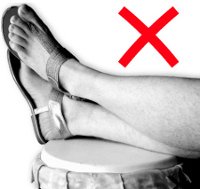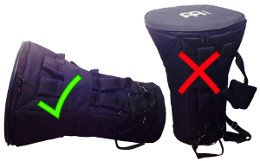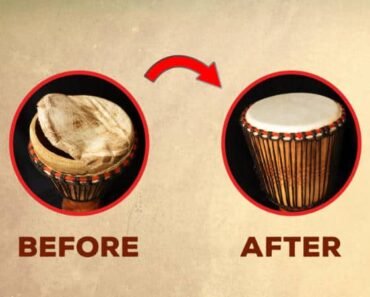
The good news is, djembe care is fairly simple. Djembes don't need much maintenance if you treat them right. They're robust and hardy like the continent they came from.
Caring for your djembe is more a case of knowing what NOT to do. Like not driving a hovercraft over it. Or not using it as a traffic cone. Those are two good tips straight off the bat.
Avoid these 6 sins and your drum will give you years of joy and happy djembe-ness without so much as a sniffle.
1. Don't sit, lean or rest objects on the face of the drum
The playing area of the drum is under a lot of tension, so any hard edges may stretch or tear it.That means no feet, coffee cups or Aunt Bertha

2. Don't play with rings or bangles
This is a big one, simply because you can damage your drum, your rings and your hands all in one go."Hey shoo-wow babe, I know your jewellery sounds amazing, but it's like, so not feng shui."
3. Don't heat the skin
Some players do this to 'warm up' the skin. Possibly they're trying to warm themselves up, who knows? It was traditionally done to dry and tighten the skin, but it's not needed anymore since rope is used instead of leather or wooden pegs. Rapid heating and cooling can tear or burst the skin.Try it with a fibreglass djembe and you'll melt it.

Steve quickly regretted heating his drum skins.
4. Don't play with sticks
It's a simple rule. Break it and I'll take those sticks off you and play a solo on your tender regions.
Here, pass me those quickly

5. Don't grease the skin
There's no need for dubbin, oil or any other leather treatment. No scrubbee da drumee, see?
6. Don't store the drum vertically
Leave the drum on it's side when you're not playing it. This reduces tension and the likelihood of the skin breaking when not being used.You can pretend that it's sleeping. Aw.

Are these pretty pictures helping?
7. Buy a good bag
OK, so this is a 'do' but it has to be said. If you're not careful, your skin or the drum shell can break during transport. Then you'll be in tears and I'll have to say I told you so.Thusly, make sure you get a good bag with strong padding for the head area. You can read more about djembe bags here.
There you have it. If you've ignored our sage advice and broken your drum skin, no pudding for you. And you'd better see our page on djembe reskinning.
| This post may contain affiliate links. If you click on the links and buy, we get a commission. It doesn’t cost you anything. See the full disclaimer here. |






